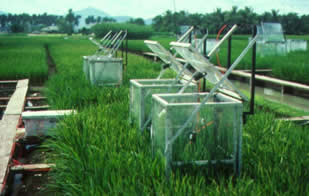 Methane is a greenhouse gas that is 20 times more active radiatively than carbon dioxide and strongly influences the photochemistry of the atmosphere.
Methane is a greenhouse gas that is 20 times more active radiatively than carbon dioxide and strongly influences the photochemistry of the atmosphere.
The concentration of methane in the atmosphere has more than doubled over the last 200 years, and in particular, has increased by about 50% in the last 40 years. It has been estimated that the increase in methane concentration may have contributed about 15% to anthropogenic greenhouse effects.
Rice paddies are a major source of atmospheric methane. The total annual global emission of methane is estimated at 500 Tg yr-1, but the accuracy of this estimate is highly uncertain.
Improving estimates of methane emission at the regional and global scales requires process-based models, integrating the environmental and biological factors that determine the rate of methane emission.
The Interregional Research Programme on Methane Emissions from Rice Fields
The Interregional Research Programme on Methane Emissions from Rice Fields, funded by the Global Environmental Facility of the United Nations Development Program, was established to improve understanding of the processes of methane emission in rice agriculture, and to evaluate options for reduction of these emissions.
 This research project was based at the International Rice Research Institute, and involved national rice research institutes in China, India, Indonesia, Philippines, and Thailand.
This research project was based at the International Rice Research Institute, and involved national rice research institutes in China, India, Indonesia, Philippines, and Thailand.
Part of this work was to develop a process-based simulation model to provide a tool for integrating the knowledge gained from the field data collected, and to use this to provide improved estimates of national methane emission rates and to evaluate ways of reducing methane emissions from rice paddies.
The model
The MERES (Methane Emissions from Rice Eco-Systems) model is a process based simulation model describing the dynamics of methane emission from irrigated rice fields.
The model is based on the CERES-Rice crop simulation model, which is linked to an existing sub-model calculating fluxes and concentrations of methane and oxygen in submerged soils.
The rate of substrate supply for the methane-producing bacteria (methanogens) was calculated using the existing soil organic matter (SOM) routines of the CERES-Rice model from (a) the rate of decomposition of SOM including previous crop residues and any additions of organic matter, (b) root exudates (modified from the original CERES-Rice model using recent laboratory data), and (c) the decomposition of dead roots from the current crop.
A fraction of this substrate supply rate, determined by the concentration of the oxidised form of the alternative electron acceptor pool (i.e. NO3-, Mn3+, Fe3+, SO42- ions), is converted to carbon dioxide by bacteria which out-compete the methanogens, thereby suppressing methane production.
Any remaining fraction of the substrate supply rate is assumed to be potentially available for methanogenesis. The methane dynamics sub-model uses this potential methanogenesis rate, along with a description of the root length distribution in the soil profile, to calculate the steady-state concentrations and fluxes of oxygen and methane. The reduced form of the alternative electron acceptor pool is allowed to re-oxidise when soil pores fill with air if the field is drained.
Impact
In the project, MERES was used with spatial data on climate, soils, crop management practices, and rice cultivation areas to estimate total methane fluxes at national and regional levels.
The results have provided baseline data to assist rice-growing countries in more accurate accounting of greenhouse gases for national inventories and exploration of mitigation and adaptation options, thereby allowing them to comply with the stipulations of the United Nations Framework Convention on Climate Change, and begin planning for future climates.
Publications
- Matthews, R.B., Wassmann, R. and Arah, J., 2000. Using a crop/soil simulation model and GIS techniques to assess methane emissions from rice fields in Asia. I. Model development. Nutrient Cycling in Agroecosystems, 58: 141-159.
- Matthews, R.B., Wassmann, R., Buendia, L. and Knox, J., 2000. Using a crop/soil simulation model and GIS techniques to assess methane emissions from rice fields in Asia. II. Model validation and sensitivity analysis. Nutrient Cycling in Agroecosystems, 58: 161-177.
- Knox, J., Matthews, R.B. and Wassmann, R., 2000. Using a crop/soil simulation model and GIS techniques to assess methane emissions from rice fields in Asia. III. Databases. Nutrient Cycling in Agroecosystems, 58: 179-199.
- Matthews, R.B., Wassmann, R., Knox, J.W. and Buendia, L., 2000. Using a crop/soil simulation model and GIS techniques to assess methane emissions from rice fields in Asia. IV. Upscaling of crop management scenarios to national levels. Nutrient Cycling in Agroecosystems, 58: 201-217.
- Matthews, R.B. & Wassmann, R., 2003. Modelling the impacts of climate change and methane emission reductions on rice production: a review. Eur. J. Agron. 19:573-598.
Contact: Dr Robin Matthews
Funded by:
 through the
through the

|
Updated: 23 Jan 2024, Content by: RM
|
